Thien Canh Son Cave: Exploring the Hidden Gem of Bai Tu Long Bay
In the vast, emerald waters of Northern Vietnam, where limestone karsts rise majestically from the sea, lies a treasure often overshadowed by its more famous neighbors. Thien Canh Son Cave, nestled in the serene Bai Tu Long Bay, offers travelers a glimpse into nature's artistic genius away from the bustling crowds typical of Halong Bay. This mystical cavern, with its shimmering stalactites resembling crystal chandeliers, has captivated the hearts of adventurous travelers seeking an authentic experience in Vietnam's most celebrated natural wonder.
A Hidden Paradise: Location and Journey to Thien Canh Son Cave
Thien Canh Son Cave is situated on Hon Co Island (Grass Island) within the Cong Do Nature Reserve area, which forms part of the larger Bai Tu Long Bay—an extension of the world-famous Halong Bay. Located approximately 20 kilometers from Tuan Chau International Port in Halong City and about 25 kilometers from Bai Chay Port, this natural masterpiece remains relatively untouched compared to other attractions in the region.
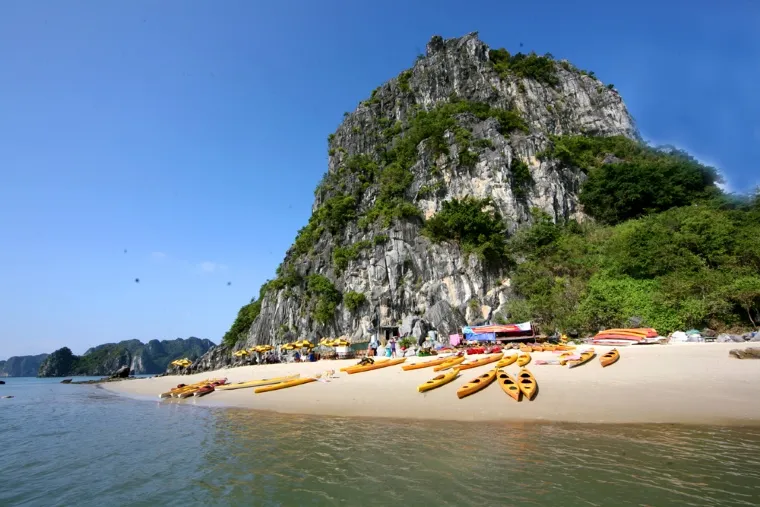
Located in Bai Tu Long Bay, Thien Canh Son Cave offers a scenic journey through peaceful waters and limestone karsts - Photo Source: baoquangninh
The most common way to reach Thien Canh Son Cave is by boat, typically as part of a Halong Bay cruise that includes stops along Route 4. From Halong Port, the journey takes approximately 1.5 hours, traversing approximately 20 kilometers of stunning seascape. While many travelers opt for organized tours, adventurous souls can arrange private boats or kayaks for a more personalized experience, which also provide an excellent opportunity to explore other attractions like Luon Cave - a picturesque spot often praised in Luon Cave reviews for its peaceful paddling experiences through water tunnels surrounded by towering cliffs, though at a higher cost
Bai Tu Long Bay, where the cave is located, is renowned for its pristine beauty and tranquility—a welcome respite from the more commercialized areas of Halong Bay. The journey itself becomes part of the adventure, as visitors glide through calm waters surrounded by towering limestone formations draped in lush greenery, offering countless photo opportunities before even reaching the cave entrance.
Symphony of Stone and Light: Exploring the Interior Beauty
The exploration of Thien Canh Son Cave begins with a modest physical challenge—ascending a series of stone steps leading to the entrance. Various sources cite different numbers, ranging from 100 to as many as 400 steps, but regardless of the exact count, the climb serves as a brief warm-up before the visual feast that awaits inside.
The cave's structure typically comprises two or three main chambers interconnected by narrow passages. Upon entering, visitors are immediately greeted by a spectacular display of stalactites and stalagmites, naturally sculpted over millions of years through the patient work of water and time. Natural light filters through openings in the cave ceiling, creating ethereal light beams that dance with the internal humidity, illuminating the cave's interior with an almost supernatural glow.
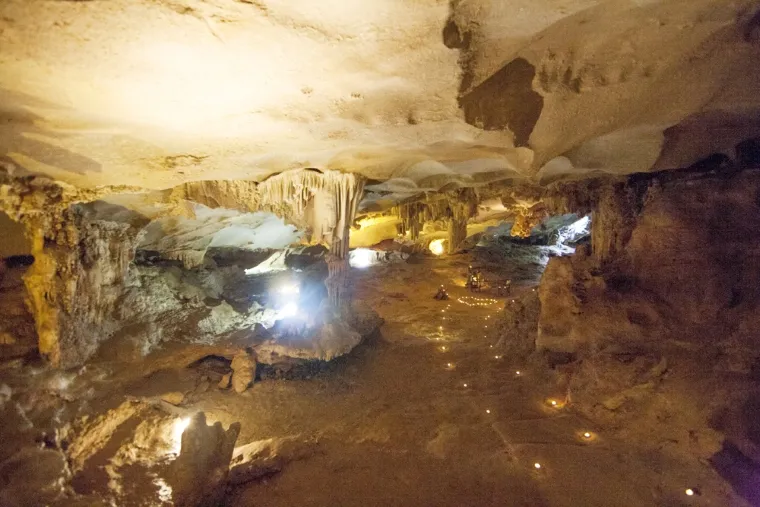
Inside the cave, stunning stalactites, natural light, and panoramic bay views create a magical underground landscape - Photo Source: baoquangninh
The ceiling of Thien Canh Son Cave has been poetically described as a tapestry of precious stones, with stalactites hanging down like ornate chandeliers. Visitors can let their imagination run wild as they observe the various formations resembling flowers, monkeys, seals, and other fanciful shapes created by nature's artistic hand. From certain vantage points within the cave or near its entrance, panoramic views of Bai Tu Long Bay unfold before your eyes, adding another dimension to this already mesmerizing experience.
Traveler's Guide: Essential Information for Your Visit
Best Time to Visit
The ideal time to visit Thien Canh Son Cave is during the dry season, from October to April, when weather conditions are pleasant with minimal rainfall. The remaining months are also suitable for visits, though travelers should be aware that the rainy season from April to September may affect itineraries. Summer months (June to August) offer excellent conditions for water activities around the cave area.
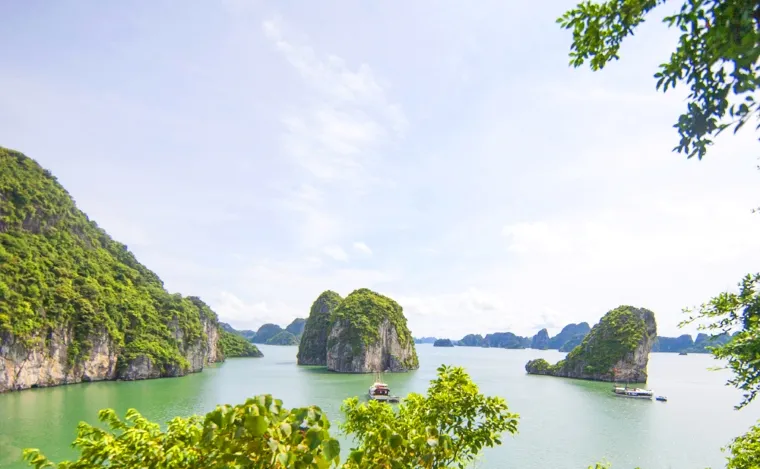
Plan your visit with tips on the best time, entry fees, and practical advice to fully enjoy the cave experience - Photo Source: baoquangninh
Operating Hours and Admission
The cave typically welcomes visitors according to cruise ship schedules, with operating hours generally spanning from 8:00 AM to 8:00 PM daily. However, specific times may vary, so it's advisable to confirm with your tour operator when booking.
Admission to Thien Canh Son Cave is usually included in the price of Halong Bay cruise tours, particularly those following Route 4. The fare for Route 4 is approximately 240,000 VND per person (about $10 USD), which includes port fees and travel insurance.
Planning Tips
To ensure a smooth experience, visitors should book tours in advance, especially during the peak season from December to March. While private boat or canoe rentals offer more flexibility in exploring the cave, they come at a higher cost.
When visiting the cave, comfortable athletic shoes are recommended for navigating the steps and interior pathways. Don't forget to bring hats, sunscreen, and sunglasses if you plan to swim or participate in outdoor activities. A camera is essential to capture the cave's breathtaking beauty, and a small flashlight might prove useful in some of the dimmer areas.
Beyond the Cave: Exciting Nearby Attractions and Activities
Bai Tu Long Bay itself is a magnificent destination with its dramatic natural scenery. Near the cave, Hon Co Beach beckons with its fine white sand and crystal-clear waters—an ideal spot for swimming and kayaking adventures.
Tours following Route 4 often include visits to other attractions such as Vung Vieng Fishing Village and Thay Cave, offering visitors opportunities to learn about local cultural life and explore other cave systems. These additional stops provide a more comprehensive understanding of the region's natural and cultural landscape.
For those with extra time, other famous attractions in the Halong Bay area worth visiting include Sung Sot Cave, Bai Tho Mountain, and Hon Ga Choi (Fighting Cockerels Islet). Route 4 may also include the Tung-Ang Ecological Area, Cap La Cave, and Hon Xep Park, each offering its own unique charms and experiences.
For the culturally curious, plan your trip during one of the traditional festivals in Ha Long Bay—such as the Cua Ong Temple Festival or Halong Carnival. These events showcase vibrant local heritage, music, and traditional performances, adding cultural depth to your visit.
Weather Patterns and Seasonal Considerations
Understanding the seasonal variations can significantly enhance your Thien Canh Son Cave experience. The region experiences four distinct seasons, each offering a different perspective on this natural wonder.
Spring (February to April) brings mild temperatures and occasional light rain, creating a mystical atmosphere as mist often surrounds the limestone karsts. Summer (May to August) offers warm weather perfect for combining cave exploration with swimming and water activities, though occasional afternoon thunderstorms may occur.
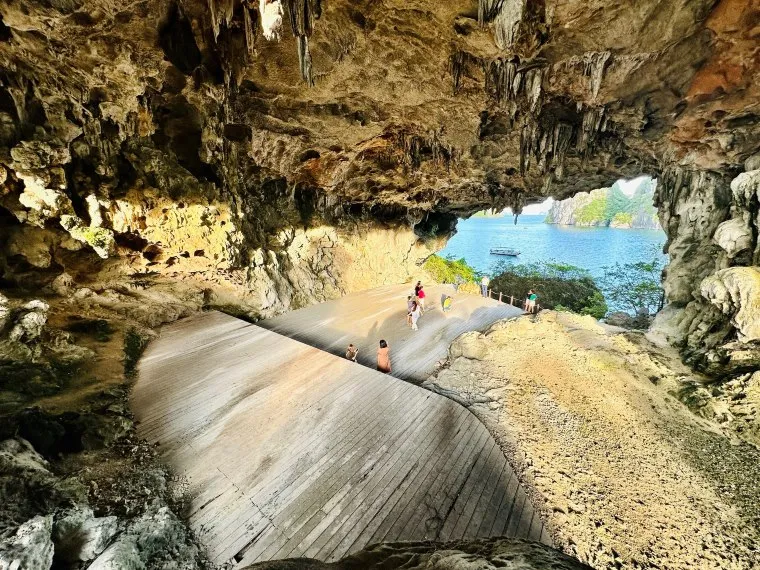
Each season offers a different perspective of the cave and bay, from misty spring to photogenic autumn - Photo Source: Báo Thanh Niên
Fall (September to November) is arguably the most photogenic season, with clear skies providing perfect visibility for capturing the cave's interior details and the surrounding landscape. Winter (December to February) brings cooler temperatures and sometimes foggy conditions that add a layer of mystery to the cave experience, though the waters may be too cold for swimming.
Regardless of when you visit, the cave's interior maintains a relatively stable temperature year-round, making it an all-season destination. However, during heavy rain periods, some tour operators might adjust itineraries for safety reasons, so flexibility in your travel plans is advisable.
Cultural Significance and Conservation Efforts
Thien Canh Son Cave holds special significance in Vietnamese folklore and local traditions. The cave's name itself reflects the reverence local people have for this natural formation, considering it a place where heaven and earth connect. For generations, fishermen in the area have viewed the cave as a symbol of good fortune and natural abundance.
In recent years, as tourism has increased throughout Halong Bay, conservation efforts have intensified to protect the delicate ecosystem of Thien Canh Son Cave. These initiatives include regulated visitor numbers, designated pathways to prevent damage to formations, and educational programs about the geological and ecological importance of the site.
Visitors are encouraged to practice responsible tourism by staying on marked paths, refraining from touching the stalactites and stalagmites (as oils from human hands can impede their growth), and taking all trash with them when they leave. By observing these simple guidelines, tourists contribute to preserving this natural wonder for future generations.
Photography Tips for Capturing Cave Magic
Photographing inside caves presents unique challenges, but with some preparation, you can capture stunning images of Thien Canh Son's interior marvels:
-
Bring appropriate equipment: A camera with good low-light performance is ideal. While professional cameras offer the best results, modern smartphones with night mode can also capture impressive images.
-
Use a tripod: The dim lighting inside the cave often requires longer exposure times. A compact, travel-friendly tripod can make a significant difference in image quality.
-
Work with available light: The natural light beams filtering through the cave openings create dramatic effects. Position yourself to capture these rays illuminating the formations.
-
Be mindful of flash use: If flash photography is permitted, use it sparingly and considerately to avoid disturbing other visitors. A diffused flash often produces better results than direct flash in cave environments.
-
Capture scale: Include people in some shots to provide a sense of the cave's massive proportions.
-
Look for reflections: In some parts of the cave, small water pools create perfect mirrors for stalactites, offering opportunities for symmetrical compositions.
Remember that experiencing the cave firsthand should take precedence over photography. Take time to put down your camera and simply absorb the magical atmosphere that has captivated visitors for generations.
What Makes Thien Canh Son Cave Unique
While Halong Bay boasts numerous caves, several features set Thien Canh Son apart:
-
Less crowded experience: Being located in Bai Tu Long Bay rather than the central Halong Bay area means fewer tourists and a more peaceful atmosphere.
-
Exceptional stalactite formations: The cave's stalactites are particularly diverse in shape and size, creating a more varied visual experience than many neighboring caves.
-
Natural lighting: The way natural light penetrates the cave creates an almost spiritual ambiance not found in artificially lit caves.
-
Panoramic viewpoints: Few caves in the region offer such spectacular vantage points overlooking the bay.
-
Pristine condition: Thanks to its protected status and regulated tourism, the cave remains in excellent condition with minimal human impact.
-
Rich local folklore: The stories associated with various formations add cultural depth to the geological wonder.
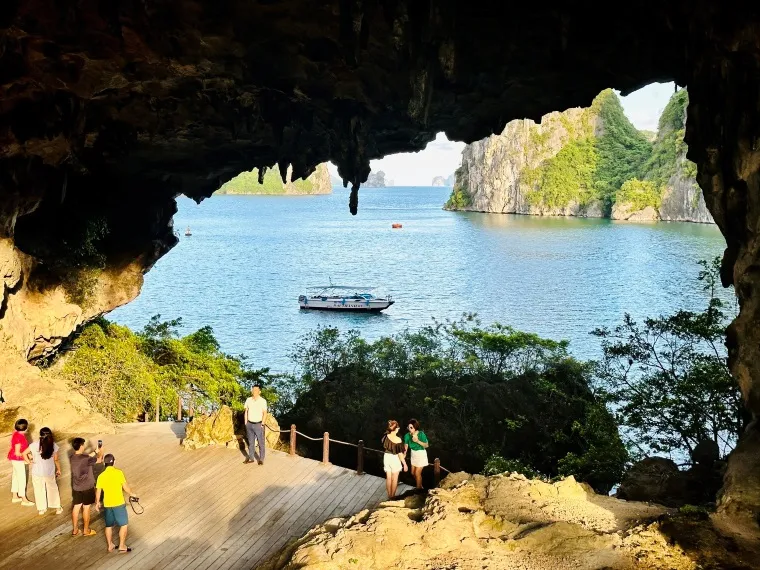
Use natural light, tripods, and composition tricks to photograph the cave’s surreal interior effectively - Photo Source: báo thanh niên
These distinctive characteristics make Thien Canh Son Cave a must-visit destination for travelers seeking authentic natural experiences beyond the standard tourist circuit.
Conclusion
Thien Canh Son Cave truly stands as an unmissable destination when exploring Halong Bay. With its mysterious beauty, tranquil atmosphere, and exciting surrounding activities, this cave promises unforgettable experiences for travelers. From the glistening stalactites to the breathtaking views of Bai Tu Long Bay from elevated vantage points, every moment spent here becomes a cherished memory.
As you plan your journey to Northern Vietnam, consider allocating time to explore this natural masterpiece. Whether you're an adventure seeker, nature enthusiast, or photography lover, Thien Canh Son Cave offers a perfect blend of awe-inspiring scenery and peaceful contemplation. Step away from the more frequented tourist paths and discover why this hidden gem continues to captivate those fortunate enough to venture into its mystical chambers.
With a well-planned itinerary, comfortable footwear, and an appreciation for nature's artistry, your visit to Thien Canh Son Cave will surely rank among the highlights of your Vietnamese adventure. Let the timeless beauty of this geological wonder inspire you, as it has inspired countless visitors before.
|
Joytime Travel Agency - Travel JOY, TIMEless Vietnam Follow us for travel tips, local insights, and exclusive offers:
|

Danish Nguyen
Danish Nguyen is a renowned travel blogger in Vietnam with over 5 years of experience sharing unique travel experiences. With a passion for exploring new places, Danish captures incredible moments and provides readers with valuable tips to discover the beauty of his homeland.


















